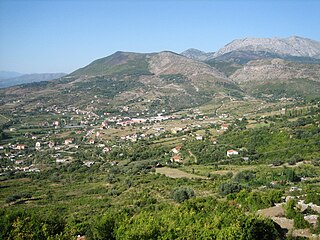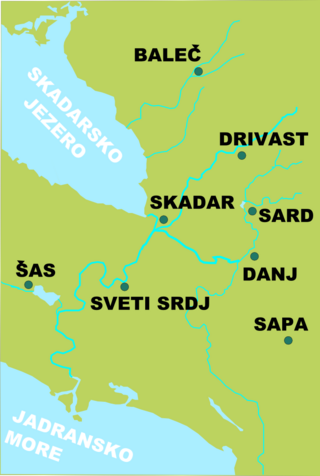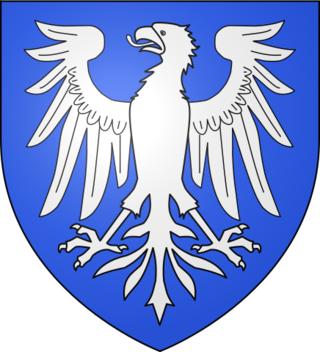
| Part of a series on |
| Albanian tribes |
|---|
 |
Zadrima is an ethnographic region situated in north-western Albania between the cities of Shkodra and Lezha, located left of the Lower Drin which eventually drains into the Adriatic Sea from near Lezha.

| Part of a series on |
| Albanian tribes |
|---|
 |
Zadrima is an ethnographic region situated in north-western Albania between the cities of Shkodra and Lezha, located left of the Lower Drin which eventually drains into the Adriatic Sea from near Lezha.
The Zadrima Plain includes villages and settlements administratively split between the modern Shkodra (Vau i Dejës Municipality) and Lezha (Lezhë Municipality) counties. The following belong under the Vau i Dejës Municipality: [1]
While the settlements below come under the Lezhë Municipality: [1]
At the end of the eighteenth century, Zadrima came to also encompass the nearby villages of Vjerdha, Lisna, Gajtani, and Rragami. The settlements of the former Guri i Zi Municipality, located to the immediate north of Zadrima, are traditionally connected to Zadrima due to similarities in traditions, customs, and folk clothing. On the other hand, the villages of Kallmet i Vogël, Kallmet i Madh, and Rraboshta, which are a part of the southern Zadrima Plain, differ in their customs and traditions from the rest of the greater region. Zadrima can be further broken down into three main units: 1) The area bordering Mirdita, consisting of villages located on the foothills of the mountains separating the two major ethnographic regions (e.g., Troshan, Fishtë, Nënshat); 2) The villages established on the slopes of hills and mountains located within the core territory of Zadrima (e.g., Paçram, Pistull, Dajç); 3) The villages located on the open plains of Zadrima (e.g., Gramsh, Shelqet, Gjadër). [1]
Zadrima is first recorded in the twelfth and thirteenth centuries by Byzantine princess and historian Anna Komnene who refers to the region as highly agricultural and the place of many battles between the Western and Eastern Roman empires. In 1281 the progenitor of the Dukagjini family, dux Gjin Tanushi (Ducam Ginium Tanuschium Albanensem), [2] is recorded as ruling over portions of Zadrima, Guri i Zi (Montagne noire), Pulti, Sati, and lands around the Fan. [3] Much of Zadrima and the adjacent territories between Lezha and the Fan would consequently be inherited by the Dukagjini, particularly the branch descending from Tanush II Dukagjini. [4] Other than the Dukagjini, the noble families of the Blinishti and Zaharia also held lands in Zadrima. The Blinishti of the thirteenth and fourteenth centuries initially held the lands between Gjadër in the west and Mali i Shejtit to the east, Arst in the north and Ndërfanda in the south, with their centre in Blinisht. [5] In the fifteenth century it is recorded that Koja Zaharia had received lordship over Sapa and Dagnum from the papacy following his conversion to Roman Catholicism from Serbian Orthodoxy in 1414. The Zaharia would continue to rule over much of Zadrima during the medieval and often came into land disputes and conflicts with the Dukagjini whose influence had been primarily limited to Lezha and its environs. Zadrima and Lezha would eventually fall under Venetian occupation. [6]
The demographic history of Zadrima is one of heterogeneity and diversity in regards to geographic origins. The old population of the region, descended from the medieval inhabitants and communities of Zadrima, has largely diminished and represents a negligible percentage of modern families. For example, in the seventeenth century only a handful of native households remained in the village of Mjeda, such as that of Lazër Mati Koja which was descended from the old Zaharia family through Koja's son, Leka. The Ottoman occupation of the region resulted in mass depopulation and movement out of Zadrima, explaining the great reduction in the region's native population. [6] From the sixteenth and seventeenth centuries onwards, Zadrima would come to be repopulated by a number of families and brotherhoods arriving from Malësia. [7] Examples include a number of the brotherhoods from Gjatore, a quarter in Kallmet, whose ancestors arrived from Vukël in Kelmend, [8] as well as the Lazër-Ilaj of Pistull who are believed to have come from Hoti. Numerous families from Mirdita and Puka also settled in Zadrima due to their close proximity to the region, which offered better living conditions due to its lowland terrain. Migrations from other nearby territories would also take place, examples including the Imeraj of Paçram who descend from the Çelaj of Bushat and the Ranxa of Pistull who arrived from Melgushë. [9]

Lezhë is a city in the Republic of Albania and seat of Lezhë County and Lezhë Municipality. It is one of Albania's continuously inhabited cities, with roughly 2,400 years of recorded history.

Lezhë County is one of the 12 counties of Albania. The population as of 2021 was 120,678, in an area of 1620 km². Its capital is the city Lezhë.
Blinisht is a village and a former municipality in the Lezhë County, northwestern Albania. At the 2015 local government reform it became a subdivision of the municipality Lezhë. The population at the 2011 census was 3,361.
Dajç is a village and a former municipality in the Lezhë County, northwestern Albania. At the 2015 local government reform it became a subdivision of the municipality Lezhë. The population at the 2011 census was 3,834.

Vau i Dejës, English: Deja's Ford, is a town and a municipality in Shkodër County, northwestern Albania. It was formed at the 2015 local government reform by the merger of the former municipalities Bushat, Hajmel, Shllak, Temal, Vau i Dejës, and Vig-Mnelë, that became municipal units. The seat of the municipality is the town Vau i Dejës. The total population is 30,438, in a total area of 499.35 km2. The population of the former municipality at the 2011 census was 8,117.

Dagnum was a town, bishopric and important medieval fortress located on the territory of present-day Albania, which has been under Serbian, Venetian and Ottoman control and remains a Latin Catholic titular see. It is close to the modern day town of Vau i Dejës.
Rraboshtë is a village located in the former Kallmet municipality, Lezhë County, northwestern Albania. At the 2015 local government reform it became part of the municipality Lezhë. The village is situated near the river Drin, about 4 km north of the city Lezhë. Nearby mountains include Mali Kastriot and Mali i Velës.

The Dukagjini are an Albanian noble family which ruled over an area of Northern Albania and Western Kosovo known as the Principality of Dukagjini in the 14th and 15th centuries. They may have been descendants of the earlier Progoni family, who founded the first Albanian state in recorded history, the Principality of Arbanon. The city of Lezhë was their most important holding.

Bardhok Biba was an Albanian politician who was a key political figure of the Mirditë region serving as political secretary of the party committee in the district. Biba was also a member of the People's Assembly. He was awarded the title of Hero of the People.
The Blinishti were a medieval Albanian feudal family that held lands in modern northern Albania between the thirteenth and fourteenth centuries. They governed a territory spanning from Gjadër in the west to Mali i Shejtit in the east, and from Fushë-Arrëz in the north to Ndërfanda in the south of their domain. Their core settlement was modern Blinisht north of Lezhë.
Pjetër Zarishi or Dom Pjeter Xarishi was an Albanian Mirditë Catholic priest and poet who established a tradition of the 19th century Catholic literature in northern Albania. He is also noted for his literary contribution to the Albanian National Awakening. His poems were primarily religious and in less extent secular.
Paçram is a settlement in the former Hajmel municipality, Shkodër County, northern Albania. At the 2015 local government reform it became part of the municipality Vau i Dejës.

Preng Doçi (1846–1917), Italian: Primus Docci, was and Albanian political and religious figure and poet. He was a main contributor in the Albanian Bashkimi Alphabet.

The Principality of Dukagjini refers to the domains (zotërimet) of the Albanian Dukagjini family in northern Albania and western part of the modern-day territory of Kosovo in the 14th century and 15th century. At their maximum extent, the domains of the Dukagjini extended from Upper Zadrima in the northwest to the Plain of Dukagjini in western Kosovo. The political center of the Dukagjini family was Lezhë until 1393 when it was surrendered to Venice in order to not fall under the Ottomans. The Ottoman sanjak of Dukagjin was named after the rule of the family in the areas that formed it.

Kodheli is a small village located in the center of Zadrima plain in the Lezhë County, northwestern Albania. At the 2015 local government reform it became part of the municipality Lezhë.

The Mjeda family, is a noble Albanian family which played a prominent role in the history of Albania and Kosovo in the 19th and early 20th century.
Convention of Dukagjin or Assembly of Dukagjin was a convention of Albanian nobles and leaders held in the village of Macukull, in the Mati region, on November 1601, lasting to February 15, 1602. The convention was attended by 2656 representatives, and included both secular and religious representatives, from various Albanian districts. There were Albanians from the highlands of Shkodër, Zadrima, Dukagjin, Kosova, Lezha, Kurbin, Mirdita, Mat, Dibra, Petrela, Durrës, Elbasan, Shpat and from Myzeqe. The convention was headed by Nikollë Bardhi, Gjin Gjergji and Nikollë Mekajshi. The convention decided to wage war against the Ottoman Empire in an attempt of liberation. The decision was approved by 56 main leaders, consisting of 13 representatives who all sealed the act which the text “Sigillum Regni Macedonia et Albaniae” with the double-headed eagle. Prior to this meeting, there had been the Convention of St. Maria in Mati in 1594, the Convention of Zadrima in 1598 and 1601 in Dukagjin. In 1608 another convention was held in Moraca and Dukagjin and in 1614, in Kuci.

The Manatia are a historical Albanian tribe (fis) and tribal region in the district of Lezha of northern Albania. It is one of the four traditional bajraks of the Highlands of Lezha, alongside the Kryezezi, Vela and Bulgëri.
Gjin Tanushi was a 13th-century Albanian nobleman who held lands in Ndërfandë, corresponding to the region of Mirdita in north-central Albania. He was also the progenitor of the Dukagjini family which ruled over an area of northern Albania and western Kosovo during the medieval period, their most important holding being that of Lezhë.